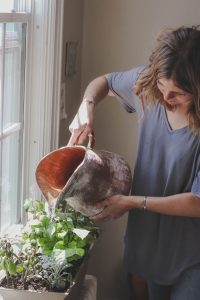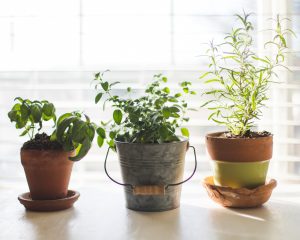If, at the end of the growing season, you wonder where you’ll get herbs during the next three seasons, consider building an indoor herb garden. It’s easier than you may think, even for those who don’t have the greenest thumb. The rewards of having an indoor herb garden go beyond having fresh seasonings all year. They include adding oxygen, natural fragrances, bright colors, and pretty foliage to your indoor environment.
Indoor herb gardens put you in control rather than Mother Nature. Sure, they still depend on the sun, but you get to choose the best soil, the amount of water, the temperature, and even the container that helps them grow. Not only is it a learning experience, but you also get to be creative. Plus, you don’t have to worry about insects destroying your plants.
Below are simple tips to help you build your indoor herb garden.
Choose the Right Herbs
When choosing the right herbs for your indoor garden, evaluate the herbs you use during the outdoor growing season. Out of those herbs, select the ones you will use the most throughout the year, even in the winter months. You can look in your pantry to see which herbs you purchase the most. By growing your own, you will save money, another benefit.
Once you have a list of herbs you want to grow, research which ones are the easiest for beginner gardeners. Learn more about herbs in the “Tips for Growing Herbs Indoors” section below.
Choose Your Supplies
You will need containers and soil to build an indoor garden. You may want to start with small containers, especially if you grow herbs from seed or small plants. Don’t spend much money on small containers. After a few weeks, your plants will need more space to grow bigger.
Don’t buy containers that are too large, either. A key point to remember is that your plants will only grow as large as their container. If you peek at its root system, you can know if your plant has outgrown its pot. If the roots are overgrown at the bottom of the container, you need a larger one.
Containers for indoor herb gardens must have drainage holes to prevent soil compaction. On the other hand, water should not drain immediately when watering. Buying soil that produces slow drainage is best. Rather than digging up dirt from your outdoor garden, you may want to purchase indoor potting soil that contains nutrients. Indoor herb gardens do not require much soil, so this will not be expensive.
Fertilizers for growing herbs indoors should be water-soluble. Options include granular, liquid, organic, and slow release. Seaweed and fish emulsions are other options, both with many nutrients. Be aware that fish emulsion smells much worse than other fertilizers, except for manure and compost. Fortunately, not much fertilizer is needed for indoor plants. Avoid over-fertilizing, which can affect growth and flavor.
Some people prefer to make fertilizer instead of purchasing it at a garden center. Banana peels, crushed eggshells, coffee grounds, and Epsom salts are a few options.
Choose Your Location
Herbs, like most other plants, need sunlight to grow. Therefore, you must find a place in your home where they will get sunlight throughout the day. If you do not have adequate sunlight for at least six hours out of the day, you may want to invest in grow lights.
Most people use a windowsill in their kitchens, sunrooms, on shelves, or on the floor. Another critical factor in growing healthy herbs is the indoor temperature. Herbs are more likely to succeed at temperatures between 60 and 70 degrees.
Place your herbs far enough apart that they allow good airflow. They need room to breathe.

Tips for Growing Herbs Indoors
Basil, a very versatile herb, likes temperatures warmer than other plants. It produces well, and two or three plants are plenty for a family of four. Oregano is a very hardy plant, so temperature is not a big issue. However, they may burn if the leaves press against a hot window for too long. Avoid cutting more than a third of the plant at a time.
Parsley is an easy-to-grow herb, especially from seed. For the best results, prune regularly and keep the soil consistently moist. Sage is a long-lasting plant that can last several years indoors. It needs more sun than other plants but not as much water.
Rosemary plants are prone to powdery mildew, so it’s important not to let the plant get too moist. When fertilizing, use a slow-release version. With thyme, a very aromatic plant, avoid over-watering. The leaves and stems hold flavor when you keep them clipped and trimmed.
Finally, have fun. Building an indoor garden can be an enjoyable hobby that allows you to use the freshest ingredients for cooking all year round.

